The land row of 2008 was seen a landmark year witnessing Kashmir’s transition from violence to Ahimsa, the non-violence, a fact that 2010 unrest reaffirmed. Almost half a decade later, police sought judicial help to block a Facebook page that shocked visitors with latest rebel pictures from the jungles. Bilal Handoo explains the quantum shift in Kashmir situation at a time when AFSPA is dominating the narrative
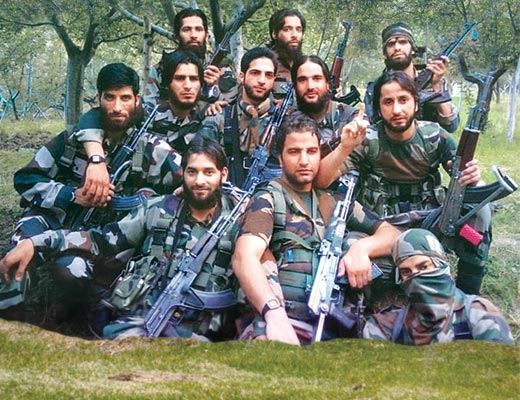
At the peak of 2010 unrest, Afroza Teli, a teenage girl from Khrew would lead stone-pelting youth from the front. Such was the level of rage that she would offer her bangles to youth retreating upon police chase. Her unflinching, rebellious street courage made many to conclude: something deep is driving this girl crazy at state and at its custodians.
As the few inch snow covered the graves of the slain of that summer, a Kupwara man set forth himself on an emotional journey to write obituaries of 120 youth. Later those obituaries became the book Waadai Khoonaab. One of the intriguing things noted by the author Ess Ahmad Pirzada was: “Most of the slain knew their fate… I had this feeling, that things are bound to cut loose, sooner or later.”
Perhaps Pirzada was right. Things did cut loose to an extent since then, that now Kashmir Police Chief SJM Gilani is asserting: Nearly 100 boys have picked up gun since 2014. The revelation dents the claims upheld by state so far—that militancy has reached to its “lowest ebb” in valley. “Interestingly, this re-emerging militancy,” continued Pirzada, “has its roots in 2007, the year when state claimed that militancy was reduced to naught in Kashmir.” And since, he said, it is gathering both mass as well as momentum.
“One may ask why it is happening when after 2008, stones had almost replaced guns in valley,” said Dr Showkat Shaheen, Kashmir’s lone strategic analyst. “Once you start analysing it, you find many contributory factors to it.” One is the rising sense in youth to identify themselves with militant’s fate, he said. “It does play at youth’s psyche when he identifies his struggle with another person, who finally found salvation in picking up guns.”
What Shaheen would perhaps never tell is the fact that in present day Kashmir, street gossip is filled with raging narratives about unabated harassments faced by youth having stone pelting history. In old city, for instance, separatists are crying hoarse over nocturnal raids and arrest spree of youth. They have expressed their apprehensions that if such things won’t stop, then state must get ready to face a massive retaliation. “You can’t toy with this generation of Kashmir, born and brought up in conflict,” said Imran Bhat (name changed), a science graduate from Srinagar, a frequent stone pelter. “Since 2010, youth are facing police harassments. Their every move is under surveillance. They often get police summons. One must understand that every person has his breaking point. And once that point comes up, then all surveillance methods are bound to backfire.”
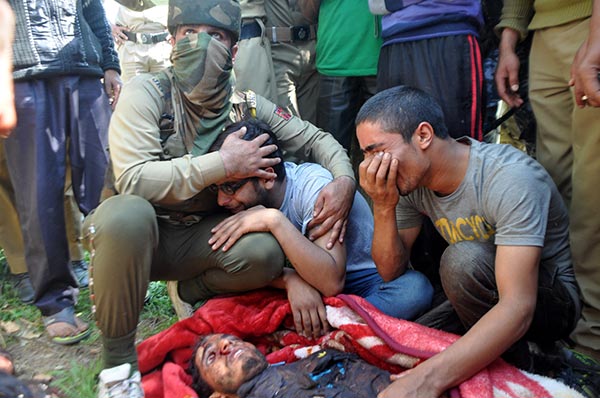
KL Image: Shah Hilal
It was perhaps the same tripping point, which forced constable Naseer Ahmad Pandit, a security guard of Syed Altaf Bukhari, minister of public works to escape with two AK-47 rifles in March this year. Few days after the incident, Hizb spokesperson Syed Sadakat Hussain revealed that Pandit had joined Hizb outfit. While making sense of constable’s move, one senior police officer said that the constable was fed up as his regular complaints against drug peddlers were constantly being turned down by his own colleagues. “He was a good cop, but was seen as a social crusader by his seniors,” the official said. “When he couldn’t take it anymore, he established contact with militants, ran away with service rifles and joined militant ranks.”
But it isn’t always a will to fight the system that motivates young to join militant ranks. For some it is the fascination that how somebody like Burhan Muzaffar Wani—a chocolate-faced teenager from Tral’s Shareebad, sobriquet as Kashmir’s new Che Guevara (a Cuban guerrilla leader whose stylized visage has become a symbol of rebellion and global insignia in popular culture) takes army head-on. This fascination motivated a teenager from Tral to give up his excellent academics and step into the shoes of a rebel.
On one fine day this past March, when a 19-year-old Ishaq Ahmad of Laribal Tral, a diligent student known as ‘Newton’, didn’t return home, his father Mohammad Ibrahim sniffed that his son has joined his idol Burhan. Ishaq is somebody who had scored 98.4 per cent in class 10 in 2011 and was ninth position holder in entire Kashmir that year. “Young boys like Burhan and Ishaq are the part of Kashmir’s fourth generation brewing in rage and driven by a deep sense of retaliation against the establishment,” said Pirzada, the author. “This generation isn’t ready to compromise. Burhan didn’t compromise even when his elder brother was killed. This generation of militancy seems firm, focussed and fearless.”
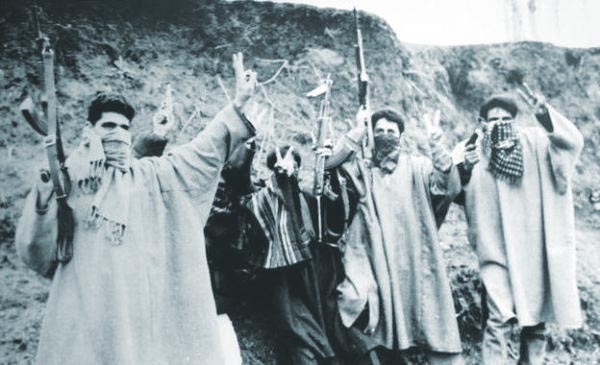
When militancy started in nineties, JKLF’s Javaid Mir shortly rose to become commander-in-chief. But Mir, known for his glamourous outlook as JKLF chief, feels that massive mobilisation of nineties proved detrimental for the movement. “I can say it with authority that ninety per cent people who joined militant ranks in nineties were novice having no experience,” Mir said, now a Mirwaiz Umar-led Hurriyat member. “That large scale intrusion later doomed the movement.” But it is not the case with new phase of militancy in Kashmir, he said. “I have no qualms to admit that the new militancy led by young boys is three-times stronger than ours. These young boys are more resolute. They were raised through harassments by government forces during last 25 years. So, they are more experienced and understand how to deal with their rivals.”
Mir’s contemporary and chairman Islamic Students League, Shakeel Bakshi, who recently urged separatist camp and militant leadership to refrain from issuing Fatwas (decrees) against “pro-resistance group” like shadowy Lashkar-e-Islam when Sopore was bleeding, believes that the new militancy is breaking the shackles of dependency. “And this very mindset is making this militancy very determined and unique,” he said. In nineties, he continued, many attempts were made to make the movement independent “but somehow it couldn’t happen. Now, these boys are setting a new example by keeping the movement indigenous besides self-sufficient”.
What Bakshi said was actually demonstrated by Burhan, somewhere deep in Tral jungles in a meeting with Lashkar group, top intelligence sources told Kashmir Life. One of the startling minutes of that meeting was Lashkar-e-Toiba offering unconditional support to Hizb but Burhan rejected it, saying, “We don’t need anybody’s support. We can run this (militancy) on our own!”
Once this lead was picked up, many intelligence officers almost scoffed at the idea, believing: “It is pure arrogance of this teen commander to even think of running militancy without weapons.” But much to their shock and awe, the boys in fatigue shortly struck by snatching service rifles from paramilitary and police personnel. “It is a kind of psychological war, where these boys are smartly sending shockwaves down the security setup of the state,” said Dr Shaheen. “Such tactics do disturb the mindset of forces on ground.” By taking such steps, he said, it shows how much level of fear has gone down in these boys. “They know it for sure that their lives are short, yet they are volunteering for it to strike a change.” These boys might have their own conviction, but Delhi sees it as radicalisation.
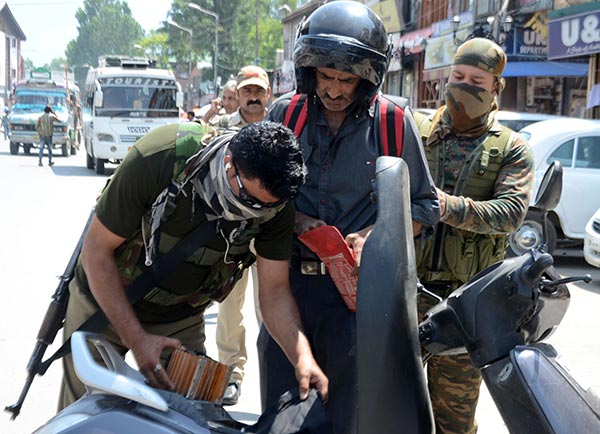
KL Image: Bilal Bahadur
And to deal with this “radicalisation”, it is said that the government is chalking out an “urgent” plan by roping in the best brains in intelligence circuit to give immediate breakthrough in the development perceived highly dangerous by security forces. For this, union home secretary LC Goyal has already entrusted this task to special secretary (internal security) Ashok Prasad—the former top cop of the state. Besides Prasad, it is said, the former Intelligence Bureau (IB) Director, Asif Ibrahim—known for his works on “de-radicalisation”, may also get the call.
But sending sleuths in guise of emissaries into state’s security amphitheatre might not be a cakewalk for Delhi on face of many challenging reports. One such report suggests that militants are focusing on two axes: one in South Kashmir’s Tral-Batapora-Panjgaon-Yaripora; another in North Kashmir’s Palhalan-Sopore. In both the axes, reports reveal, the local boys with AK-47—having superior ideological conviction than their predecessors of ninety—are giving tough time to forces.
In these twin zones, the trigger behind militancy appears a bit different. In Tral, many say rousing reception to militancy is encouraging youth to pick up arms besides a family history, glamourisation, a deep sense retaliation and media influence. “In Palhallan-Sopore belt,” said one police official, “the concept of holy war, harassment, lack of engagement, besides a heavy influence of Syed Ali Geelani’s ideology is fuelling militancy in the belt.” These multiple factors improving militant numbers have now alarmed the state’s security setup.
Some 50 boys since January this year have reportedly joined militant ranks, but IGP (Kashmir) SJM Gilani said only 35 joined this year. “Since past 18 months,” he said, “100 youths have joined militancy.” But the number isn’t alarming as such, he continued, as it is the number of a certain time period. “But yes, situation of South Kashmir is something to worry about as bulk of these recruitments has taken place from that region only.” As per police figures, out of total 150 odd militants active in valley presently, 80 alone are in South Kashmir.
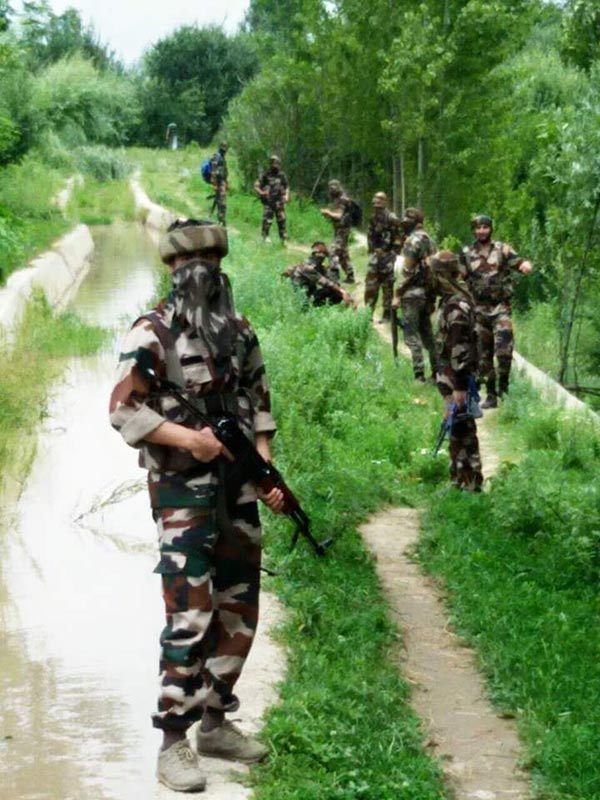
But well before South Kashmir would become valley’s new militant capital, one intelligence officer is understood to have cautioned his seniors to shift their “immediate” focus there. The warning came at that time when state’s entire focus was on North Kashmir where Azhar Malik alias Abdullah Uni—the commander-in-chief of Lashkar-e-Toiba who reportedly shot dead 15 persons, mostly security forces, including a Major and escaped 12 cordons in 9 years—was the most prized catch for the state security apparatus.
On September 13, 2011, when Uni was killed in a gunfight at Sopore’s Batpora area, the then SP Sopore, Imtiyaz Hussain, called it a huge triumph: “We are now fully confident to yet again eliminate the last remains of militancy in Sopore in next two or three months.”
Even the then Director General of Police, Kuldeep Khoda couldn’t conceal his emotions over the killing of “state’s most wanted militant”, responsible for reviving militancy in “Sopore-Kupwara-Bandipore belt since 2002”. Uni was someone believed to have established a strong base in Sopore and re-organised his group with mobilization of dozens of fresh recruits.
Uni’s death was a big jolt to LeT, as its base started shrinking fast. By February 2012, Uni’s second-in-command and top wanted Pakistani militant, Abu Akash Badar, was also killed in a fierce gunbattle in Sopore.
“The twin killings in Sopore followed by arrests of many militants had almost set off a sense in security grid that the then hotbed of militancy, North Kashmir, has been wrested from militants,” the intelligence officer said. “But I had my inputs that some militants were shifting their base swiftly to safer places like in South Kashmir (after massive crackdown on them in North Kashmir), where the home-grown small Hizb group was operational. I wasn’t taken seriously then and therefore, today we are looking at brewing South Kashmir.” Interestingly, in Hollywood flick, Pearl Harbour, the navy chief told his officers when they downplay imminent Japanese attack on safe port of Pearl Harbour: “The smart enemy hits you exactly where you think you’re safe.” The intelligence officer could only smile over the comparison.

But not everyone is smiling—at least from state’s security circles over the statement made by the telling photograph of eleven young gun-trotting guerrillas on social networking sites. Many believe that the image was taken and circulated on social media with an aim to have a “psychological edge”. But the former militant commander Azam Inqalabi, who warned India for “new phase of militancy in Kashmir” in the summer of 2008, said the photograph that went viral on social media is the brainchild of agencies. “These security agencies were in search of an opportunity to start the trend of crackdowns once again in Kashmir and these photographs of militants have provided them this opportunity,” Inqalabi said. There is a lobby in the government of India that wants to see more and more youth joining militant ranks in Kashmir, he said: “And once you are armed, they cash the opportunity to kill you. It is a dangerous strategy. We have to fight India politically.”
However, there is a feeling, especially in new generation that Kashmir being a “military state” can’t be alone run politically. They describe the present time as a “critical stage” where youth driven by “moral baggage” is running militancy without the active support of Pakistan unlike nineties. “India would say in nineties that if Pakistan withdraws its support, then the whole movement will collapse,” Javaid Mir said. “But they can’t say the same thing about today’s militancy, which is mostly home-grown and self-reliant.”
One interesting thing about today’s militancy is the fact that the youth understand that they are waging an unequal war, said Dr Shaheen. “And yet the youth are going for it as they don’t seem to fear the very consequences of it. And this is where it is going to enter into a very dangerous phase in coming time.” To contain the trend, however, many suggest that there is a desperate need to keep youth “occupied” besides “engaged”.
Usually the youth have the same aspirations everywhere, “to have a better life”. But in Kashmir’s context, said Shiv Murari Sahai, the Additional Director General of Police (ADGP) Armed Police, there is always the problem that the youth is under-occupied. “They have no occupation in the evenings particularly when they fall prey to the disruptive elements,” he believes. “So instead of being given positive occupation they are fed radical ideas of selective interpretation of history and religion.”
Those indulging in violence need to be dealt with empathetically, said Sahai, who headed Kashmir during severe crisis, and whose tenure witnessed massive youth clampdown, and engagement. “Violence is a never ending vortex,” he said. “Therefore more interaction is required at the level of law enforcement and the society to break this cycle.” Youth must be shown a future, he said. “And, it’s not without reason that after the police started counselling students in the valley that subscription to the civil service exams has increased.”
But a senior counter-insurgency officer who was part of the process when 3000 former militants were invited by police to SKICC for counselling said the new militancy is beyond an engagement and career issue. “Nineties was emotional phase, followed by reactionary phase that lasted till mid-2000 and presently Kashmir is passing through ideological phase,” he said. “And this where, it is very dangerous.”
The officer blames mishandling of situation by forces and atrocities committed during three watershed years (2008-10)—when “two youth would be killed every Friday”—for present brewing face of militancy.
The officer fears that in near future, the educational institutes will become training schools of militancy—mostly driven by “anti-India ideology” than “religious sentiment”.
“I believe situation is slipping due to inability of the government to act—who otherwise had improved security situation in 2002,” the officer said. Instead of positive engagement, PDP’s bear hug to BJP read as betrayal has also fumed a section of youth, he said. “So, unless, the trend won’t be contained through good governance and policing, it will doom us.”
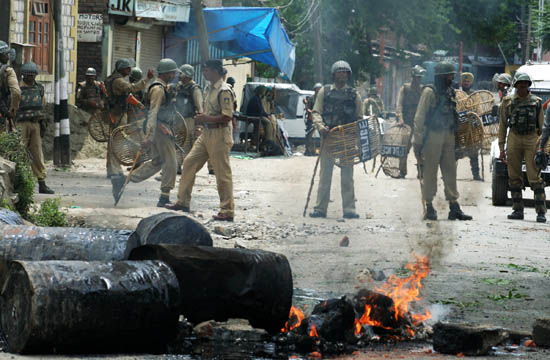
Back in 2010, Afroza—the girl stone pelter from Khrew had turned down the marriage proposal from her parents, saying: “I can’t marry. I want to bring justice to my uncle’s blood.” Her uncle, a Hizb militant, was killed in forces action. And the very thought would make her desperate to step on streets to vent her rage.
Later that year, when Waadai Khoonaab author visited Khrew, he added another obituary in his list. It was the obituary of Afroza, who was shot dead while seeking justice to her uncle’s blood on bloodied streets of Kashmir that year. And since then, rage in valley had an apparent shift from stones to guns.















